
Apart from showing that I have a head for radio and a voice for print, Tuesday night’s interview on the ABC’s The Business television program attempted to convey my belief that Australia’s banks are being squeezed by higher funding costs, which are adversely affecting their margins on new lending, and risks reducing the availability of credit in the economy.
This view was supported by the release on Tuesday of research by UBS arguing that the banks are currently losing money on new mortgages once operating costs are taken into account due mainly to rising funding costs:
A report from UBS Securities says higher wholesale funding costs and intense competition to write home loans have left the banks facing a ‘dangerous situation’, with little incentive to offer mortgages.
They can re-price the interest rate on new mortgages above the official cash rate, they can hope for wholesale funding markets to improve, or they can stop writing mortgages.
We estimate the banks are currently losing money on new mortgages written in the current funding environment. Unless the banks re-price mortgages or funding markets improve significantly, there is no direct economic incentive for the banks to continue to write new housing loans … We see this as a dangerous situation for both the banks and the broader Australian economy.
The key UBS chart showing the declining profitability of new mortgage lending is shown below:
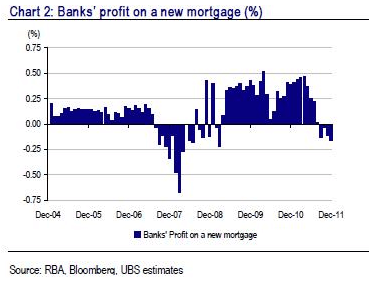
One intersting insight from the above UBS chart is that profit margins on mortgage lending were actually very low, and on occasions negative, in the years leading up to the Global Financial Crisis (GFC). This suggests that the challenges currently facing the banks not only relate to funding margin pressures, but also slowing loan growth.
In the early to mid 2000s, when mortgage credit growth averaged around 15% per annum, the banks could earn hefty profits on only slim margins. In effect, Australia’s banks were volume businesses, heavily reliant on strong credit growth in order to earn large profits. However, with mortgage credit growth now running at only 5.5% (see below chart), the banks are finding it increasingly difficult to lend profitably – a problem obviously compounded by rising funding costs.
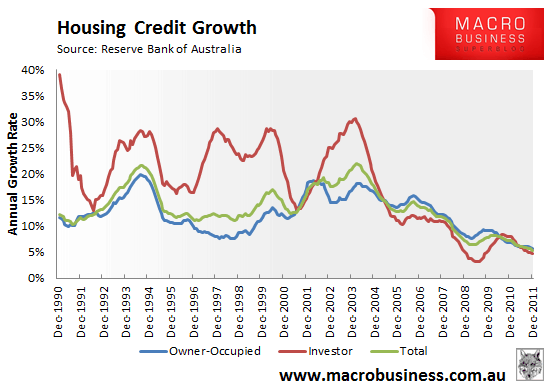
Turning back to the issue of the banks’ funding pressures, Tuesday’s article by the Prince contained the below Reserve Bank of Australia’s (RBA) chart showing that the net interest margins (NIM) for Australia’s major banks – which measures the cost gap or margin between funding costs and revenue received on loans – has more or less tracked sideways since 2005, suggesting that the banks’ margins are largely unchanged (see below chart).
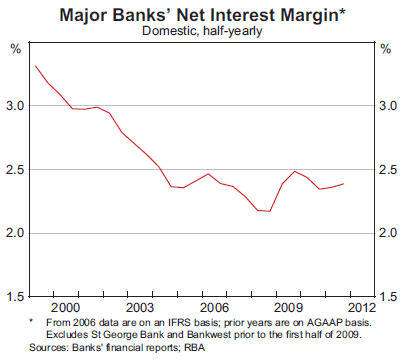
So why then the claim that the banks’ margins are being crunched?
The problem with using the RBA’s NIM figures to analyse bank funding costs is that it examines the banks’ margins across their entire loan books, the majority of which are pre-existing loans. This might be an appropriate measure to use when assessing overall bank profitability, however, it says very little about the incremental cost of writing new loans and the banks’ incentives to do so.
In my view, it is far more important to assess whether incremental margins are sufficient for the banks to lend profitably and, in the process, expand their balance sheets. As when it becomes less profitable for the banks to fund new loans, they are more likely to ration credit and restrict lending, which could have adverse consequences for the Australian economy.
To assess my claim that the banks’ incremental funding costs have risen and that the profitability of new loans is being adversely affected, below I present two charts measuring the ‘spread’ (difference) between:
- the average discount variable mortgage rate and average deposit rates; and
- the average discount variable mortgage rate and the banks’ recent covered bond issues.
First, the spread to deposits:
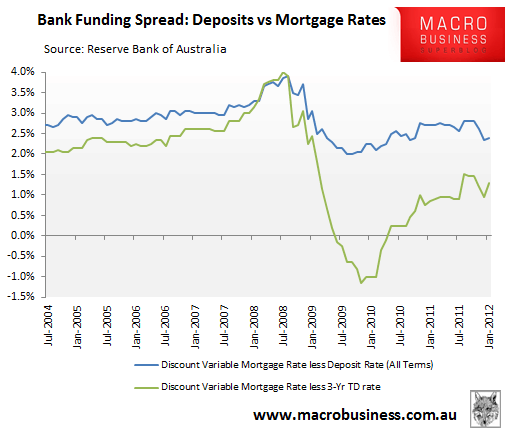
The blue line measures the spread between the discount variable mortgage rate and all deposits (at call, term, etc). The margin – currently 240 basis points – is 42 basis points below the average since 2004 (282 basis points) and 66 basis points below the pre-Global Financial Crisis (GFC) average (306 basis points); although it is well above the low reached in late 2009 (200 basis points).
Importantly, the cost of lengthening the maturity of the banks’ deposit funding appears to have worsened even more, as illustrated by the green line, which shows spread between the discount variable mortgage rate and the 3-year term deposit rate compressing to 130 basis points, which is 44 basis points below the average level since 2004 (174 basis points) and 131 basis points below the pre-GFC average; although it is well above the all-time low of -119 basis points reached in late 2009.
So overall, deposit funding is more expensive relative to before the GFC, although it has become less expensive since 2009.
Turning now to the banks’ recent covered bond issuance, which is where the whole bank funding issue gets interesting.
As has been widely reported in the press, the cost of raising wholesale debt has ballooned, with recent bank covered bond issuances raising funds at around twice the cost of unsecured debt issued in 2009:
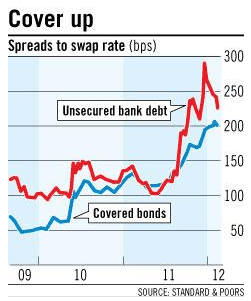
In order to illustrate the extent of the rising funding costs, the below chart estimates the all-in prices (including costs associated with swapping the bonds into Australian dollars) of the banks’ recent covered bond issues. As you can see, the banks have raised covered bond funding at costs ranging from 6.0% to 6.8%, with a total average weighted cost of 6.2%.
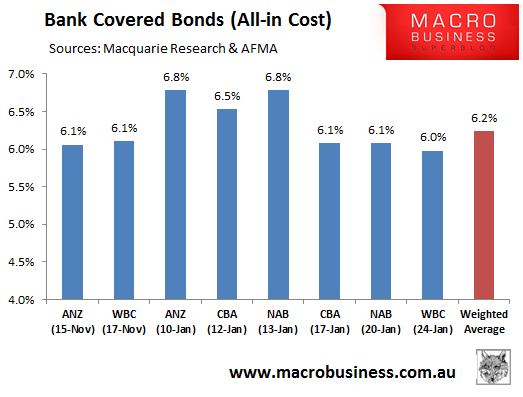
Now if we deduct these costs from the average bank discount variable mortgage rate, you see that the banks’ margins on mortgage lending have been compressed to between -0.18% and 0.74%, with a weighted average of only 0.39%:
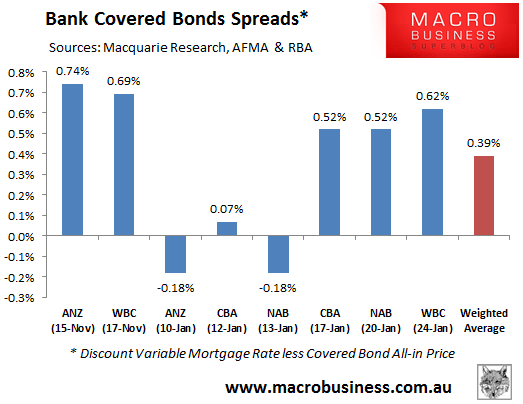
Clearly, the raising of funds via covered bonds has been extremely costly for the banks and is severely crimping their margins. And given that new bank lending must be funded via new deposits or wholesale funding, any increase in these funding costs directly impacts on the profitability and viability of new lending.
As mentioned in the UBS report quoted above, unless the banks re-price their mortgages via out-of-cycle rate rises and/or by not passing on in-full future RBA interest rate cuts, or funding markets improve significantly, there is little direct economic incentive for the banks to continue to write new loans, which could potentially lead to credit being withheld from prospective borrowers.
In this regard, Treasurer Wayne Swan needs to tread very lightly when attacking the banks. While he might extract some economic capital from shaming the banks into passing on future RBA interest rate cuts in-full to mortgage holders (or discouraging the banks from implementing out-of-cycle rate rises), he risks the banks rationing credit to mortgage borrowers and businesses.
At the end of the day, Australia’s banks will only lend where it is profitable to do so. And by acting to reduce their profitability, the Government risks reducing the availability of credit.
Be careful what you wish for, Mr Swan.

